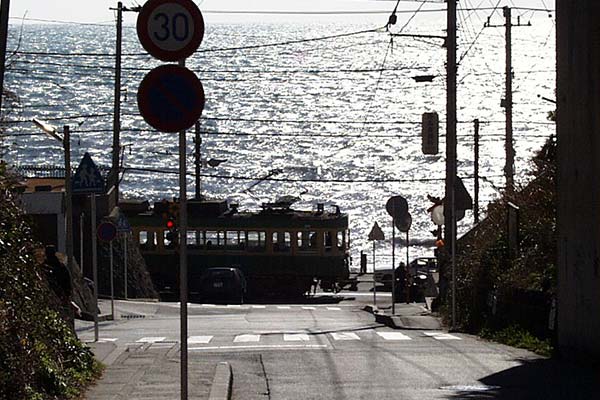Walking is best in Kamakura
Your feet are the best and most reliable tool to use in Kamakura. As are always the case with old towns in Japan, the roads here are miserably narrow. Sightseers have to share this narrow roads with motorbikes, cars, buses and tracks. With the recent sightseeing boom, the city is heavily thronged with holidaymakers throughout the year, many of them with cars. The City Assembly of Kamakura is seriously considering to enact an ordinance to restrict out-towners' car coming in and out to cope with woeful condition,--- so woeful that even Kamakuraites are unable to use their own cars inside the city. Thus, walking is the best and fastest way to look around Kamakura. Its acreage is a little less than 40 square kilometers and 30 kilometers in circumference. Fortunately, Kamakura Station is conveniently located in the middle of the city, and famous temple/shrines are found within 3-kilometer radius. Kita-Kamakura Station is also conveniently situated to visit famous Zen temples.

Unfortunately, however, today's roads are not for walkers, but for cars in Japan. Cars have priority over walkers probably because the car industry has been the driving force for the Japanese economy, whereas walkers contribute only to footwear industry. Obviously drivers are given wide latitude. In addition, Japanese drivers and traffic light systems are most dangerous among the countries I have been to. Cars never stop but speed when the light turned red. Nowhere else in the world, would drivers speed at the red light. Do not cross the roads even when the light for walkers turned green. Look right first, and then left to make sure you safe, as the cars run on the left-hand side of roads in this country.
If visiting on weekends or busy seasons, you had better buy the return ticket immediately after you got out of Kamakura Station, because in the afternoon, the station becomes backed up with long lines of passengers waiting to buy tickets. In case you are staying overnight or stay for more than one day at Kamakura, then buy the ticket on the day you leave since the ticket is good for only one day. Sophisticated automatic wickets of JR will never overlook overdue or unduly used tickets.

Near Kamakura Station, the trains run from north to south. The Station has two exits, one, east and the other, west. The east square is more spacious with a parking lot and busier than the west, surrounded with souvenir shops and restaurants. Adjacent to the west exit of the Station is a terminus of local street cars named "Eno-den" {eh-no-den}, short for "Enoshima Dentetsu" {eh-no-she-mah den-teh-tsu} run by an independent company. Eno-den trains leave here and go down south first, then west near the coast and up north to the final destination of Fujisawa {foo-gee-sah-wah}, taking 35 minutes for 10 kilometers stretch. From Fujisawa, you can go back to Tokyo by the Tokaido Line trains. Not very fast, Eno-den may be fun to have a ride or two if you have enough time.

